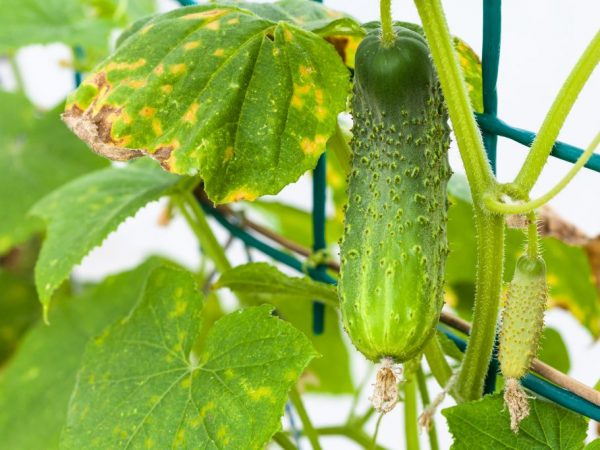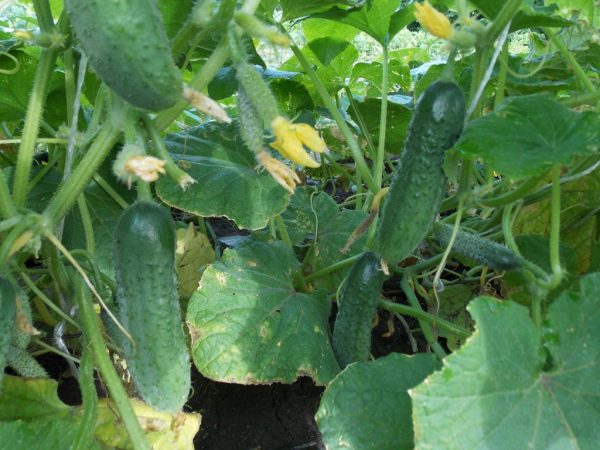How to deal with yellowing of cucumber leaves in a greenhouse
Sometimes the leaves of cucumbers in the greenhouse turn yellow, wither, dry up, wither, dry around the edges. Any process does not just happen: it says that the bush is sick or damaged by pests. If the problem is not dealt with in time, crop loss and plant death are inevitable. Let's figure out how to deal with a similar problem.

Fighting yellowed leaves in cucumbers
Causes of yellow spots
- Improper watering. Cucumber is 95% water. Insufficient moisture puts the plant under stress, so it saves water by shedding leaves. First, all the nutrients are redirected to the root and stem, then the leaves fall off.
- Incorrectly chosen area for placing a greenhouse and planting cucumbers. Different crops are planted in the same place every year, otherwise the land is depleted. Also, for planting a cucumber culture, a shaded place is chosen so that the sun does not burn the leaves.
- The defeat of the cucumber by various parasites. The whitefly (the second name is the spider mite) is the most common insect in greenhouses. It draws sap from the plant, as a result the leaves turn yellow.
- Insufficient sunlight. The rays do not reach the bottom of the bush, as a result, the lower leaves turn yellow.
- Lack of nutrients. Nitrogen starvation is displayed on the entire plant: first, it acquires a light green tint, then turns yellow, the stems become thinner. Due to a lack of calcium, the leaves are covered with yellow spots. Yellow edges appear on the lower leaves if magnesium is lacking. The upper, young leaves turn yellow due to a lack of copper. The tips are due to a lack of zinc.
- Diseases caused by a fungus. Pitiasis, Fusarium and others are the most common fungal diseases. If an infection has occurred, rusty spots appear on the leaves, gradually spreading. Consequence - the lashes wither, dry and fall off. Fungal diseases appear with sudden changes in temperature, inaccurate ventilation of the greenhouse.
- Hypothermia. The plant loves moisture and warmth. The roots are sensitive - watering with cold water will damage the plant. Overcooling of the soil is reflected in the leaves of the cucumber.
- Mechanical damage to the root system. Loosening of the soil at the seedling stage, severe damage to the root is harmful, causes wilting, drying, yellowing.
- Aging of the bush. Old age is an irreversible process. To slow down wilting, all that remains is to pick off the yellowed leaves.
Prophylaxis
Watering
To prevent the leaves from turning yellow, it is necessary to organize competent watering of the cucumbers. At the same time, inexperienced gardeners often make two mistakes:
- watered in small doses, so that the water soaks only the upper part of the soil and does not reach the roots;
- pour cucumber, which interferes with oxygen circulation.
It is necessary to check the soil for moisture, take part of the soil from the depth and squeeze it with your hand: this will help determine whether you need to water or not.
Mulch
To retain moisture, mulch the earth. The bush is covered with freshly cut grass or green weeds.This not only traps moisture, but also provides warmth.
Crop rotation
It is important to change the place of planting cucumbers every year. If a year before planting, pumpkins or zucchini were growing in the garden, it is better to choose another: there is a high risk of infection with fungal diseases. It is recommended to disinfect the soil, steam it, or use a solution of potassium permanganate. Fungi do not like an alkaline environment - before planting, the seedlings are treated with a soda solution.
Regular feeding
The soil must have a supply of all nutrients. Fertilizer is applied to the greenhouse or a warm bed is used, which can not only provide nutrients, but also warm the cucumber bushes. To prepare a warm bed, first throw out a part of the earth in the greenhouse, then lay pus or compost, cover it with a 20-30 cm ball of earth on top. You can also add mineral or organic fertilizers. The top ball of soil is sprinkled with ash to provide potassium and protect the cucumbers from pests.
Spraying bushes

Spraying will avoid wilting of the plant
The first 3-4 leaves are sprayed with soap infusion. For 10 liters of water, take 1 liter of milk, 30 drops of iodine and 20 g of laundry soap, spraying is carried out every 10 days.
To prepare another preventive infusion, bread is soaked in water, kneaded, and then iodine is added. The infusion comes out highly concentrated - it is diluted in a ratio of 1: 12-15 (1 liter of the mixture for 12-15 liters of water). Spraying is carried out every 2 weeks.
You can rejuvenate the bush by spraying it with urea and placing humus under the root. Once again in 7 days, spray with hay infusion. The infusion is prepared as follows: 1 kg of hay is soaked with 1 liter of water, insisted for 2 days.
Treatment
If the plant still turns yellow, treatment is carried out by spraying the bushes with a milk solution. Kefir or milk is suitable for the product. 2 liters of dairy products are diluted with 10 liters of water. If desired, add 150-170 g of sugar: this helps the formation of ovaries, leading to the formation of flowers.
Parasites and pests cannot tolerate onion peels. The recipe for the infusion is as follows: a liter jar is filled with onion husks, after which 12 liters of water are poured, boiled, tightly closed and left to infuse for 10-15 hours. The resulting infusion is filtered and diluted with water: 2 liters of broth for 8 liters of water. Spraying is carried out not only on the upper, but also on the lower part, the remains are poured under the bush.
Mite
The spider mite (whitefly) should not be allowed to enter the greenhouse. When opening windows or doors of the greenhouse, gauze is pulled for ventilation - this prevents the insect from entering.
Spider mites are fought by treatment with chemical or organic preparations. Garlic or dandelion infusion is often used.
To prepare the garlic infusion, take 100 g of garlic, chop until juice is obtained, and then pour it with water. Insist 5 days, and then dilute 5 g of the product with 1 liter of water.
For the infusion of dandelions, take 40 g of greens, add 20 g of dandelion root, fill with water and let it brew for 3 days.
Fungus
Diseases that affect cucumbers in a greenhouse are caused by a fungus. An environment with high humidity is a good platform for the development of fungal diseases. You can fight them using fungicides:
- Metarizine;
- Fitosporin;
- Forte;
- Benomil.
In the fight against the fungus, folk methods also help:
- Kefir solution. For cooking, mix 1 liter of kefir and 10 liters of warm water. The bushes are sprayed with a solution once a week throughout the entire period of growth and fruiting.
- Garlic solution. Prepared from 10 chopped cloves of garlic in 5 liters of water. The bushes are sprayed every 2 weeks.
Folk remedies for pest control are absolutely harmless. Such methods allow you to process the bushes so that they do not wilted.
In the initial stages of yellowing, a weak solution of potassium permanganate helps.
Conclusion
In order for the leaves of cucumbers to remain green, it is necessary to adhere to preventive measures: water regularly, treat the plant from pests and diseases, and protect it from the effects of cool nights.
Failure to comply with basic rules leads to the fact that cucumber leaves turn yellow, curl, become stained. All this affects the yield. If the leaves turn yellow only at the edges, this is not a point problem, but a whole bush.


